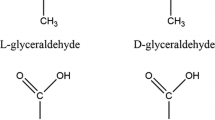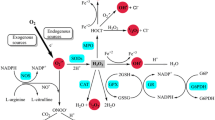Abstract
The effects of acrylamide and eight analogues on mouse brain glycolytic enzymes were studied in vitro. Most of the neurotoxic and non-neurotoxic analogues showed inhibitory effects on enolases. Their inhibitory constants, I50, for both mouse brain total enolases and purified bovine neuron specific enolase were similar for each analogue, being lowest for N,N′-methylene-bis-acrylamide and highest for methacrylamide. A neurotoxic compound, N-isopropylacrylamide, and a non-neurotoxic compound, N,N′-methylene-bis-acrylamide, showed non-competitive inhibition towards mouse brain total enolase. After preincubation of anologues in vitro for 90 min with hepatic S-9 fraction prepared from normal mice, their inhibitory potency towards brain total enolase was also seen. When the S-9 fraction was prepared from mice pretreated with phenobarbital, the inhibitory potency was not different from that of the control. After preincubation with S-9 fraction prepared from either diethyl maleate-, or piperonyl butoxide-pretreated mice the inhibitory potency was significantly greater than with non-pretreated control mice. Many of the test analogues also showed inhibition of glyceraldehyde 3-phosphate dehydrogenase activity, the highest inhibitory potency being seen with acrylamide, but no compounds inhibited phosphofructokinase.
Similar content being viewed by others
Abbreviations
- (GAPDH):
-
Glyceraldehyde-3-phosphate dehydrogenase
- (PFK):
-
phosphofructokinase
- (bovine NSE):
-
neuron specific enolase from bovine brain
- (DTT):
-
dithiothreitol
- (EDTA):
-
edetate disodium
- (NADH):
-
dihydronicotinamide adenine dinucleotide
- (NADP):
-
nicotinamide adenine dinucleotide
- (ATP):
-
adenosine triphosphate
- (PGK):
-
3-phosphoglycerate kinase
References
Beutler E (1975) Red cell metabolism. A manual of biochemical methods (2nd ed), Grune & Stratton, New York, San Francisco, London, pp 50–52
Bradley WG, Williams MH (1973) Axoplasmic flow in axonal neuropathies. Brain 96: 235–246
Chretien M, Patey G, Souyri F, Droz B (1981) ‘Acrylamide-induced’ neuropathy and impairment of axonal transport of proteins. II. Abnormal accumulation of smooth endoplasmic reticulum as sites of focal retention of fast transported proteins. Electron microscope radioautographic study. Brain Res 205: 15–28
Dairman W, Sabri MI, Juhasz L, Bischoff M, Spencer PS (1981) Protective effect of sodium pyruvate on acrylamide-induced neuropathy in rats. The Toxicologist 1: 52
Graham DG, Abou-Donia MB (1980) Studies of the molecular pathogenesis of hexane neuropathy. I. Evaulation of the inhibition of glyceraldehyde-3-phosphate dehydrogenase by 2,5-hexanedione. J Toxicol Environ Health 6: 621–631
Griffin J, Price DL, Drachman DB (1977) Impaired axonal regeneration in acrylamide intoxication. J Neurobiol 8: 355–370
Guenther WC (1964) Analysis of variance. Prentice-Hall, Inc. Englewood Cliffs, NJ pp 57–59
Hashimoto K, Aldridge WN (1970) Biochemical studies on acrylamide, a neurotoxic agent. Biochem Pharmacol 24: 1277–1282
Hashimoto K, Sakamoto J, Tanii H (1981) Neurotoxicity of acrylamide and related compounds and their effects on male gonad in mice. Arch Toxicol 47: 179–189
Hashimoto K, Tsuji H, Tanii H (1984) Distribution and binding studies of acrylamide. Neurotoxicology 5: 306–307
Howland RD (1981) The etiology of acrylamide neuropathy: enolase, phosphofructokinase, and glyceraldehyde-3-phosphate dehydrogenase activities in peripheral nerve, spinal cord, brain, and skeletal muscle of acrylamide-intoxicated cats. Toxicol Appl Pharmacol 60: 324–333
Howland RD, Vyas IL, Lowndes HE (1980a) The etiology of acrylamide neuropathology: Possible involvement of neuron specific enolase. Brain Res 190: 529–535
Howland RD, Vyas IL, Lowndes HE, Argentieri TM (1980b) The etiology of toxic peripheral neuropathies: in vivo effect of acrylamide and 2,5-hexanedione on brain enolase and other glycolytic enzymes. Brain Res 202: 131–142
Ling KH, Paetkan V, Marcus F, Lardy HA (1966) Phosphofructokinase. In: Colwick SP, Kaplan No (ed) Methods in enzymology Vol IX, Academic Press, New York, pp 425–429
Lowry OH, Rosebrough NJ, Farr AL, Randall RJ (1951) Protein measurement with the Folin phenol reagent. J Biol Chem 193: 265–275
Marangos PJ, Zowzely-Neurath C, York C (1976) Determination and characterization of neuron specific protein (NSP) associated enolase activity. Biochem Biophys Res Commun 68: 1309–1316
Rassol CG, Bradley WG (1978) Studies on axoplasmic transport of individual proteins. I. Acetylcholinesterase (AChE) in acrylamide neuropathy. J Neurochem 31: 419–425
Sabri MI (1983) In vitro and in vivo inhibition of glycolytic enzymes by acrylamide. Neurochem Pathol 1: 179–191
Sakamoto J, Hashimoto K (1984) Effects of acrylamide and analogues on glycolytic enzymes. Neurotoxicology 5: 310–311
Sakamoto J, Hashimoto K (1985) Effect of acrylamide and related compounds on glycolytic enzymes in rat sciatic nerve in vivo. Arch Toxicol 57: 282–284
Sidenius P, Jakobsen J (1983) Anterograde axonal transport in rats during intoxication with acrylamide. J Neurochem 40: 697–704
Souyri F, Chretien M, Droz B (1981) ‘Acrylamide-induced’ neuropathy and impairment of axonal transport of proteins. I. Multifocal retention of fast transported proteins at the periphery of axons as revealed by light microscope radioautography. Brain Res 205: 1–13
Spencer PS, Sabri MI, Schaumburg HH, Moore C (1979) Does a defect of energy metabolism in the nerve fiber underlie axonal degeneration in polyneuropathies? Ann Neurol 5: 501–507
Spencer PS, Sabri MI, Politis M (1980) Methyl N-butylketone, carbon disulfide, and acrylamide: Putative mechanism of neurotoxic damage. In Manzo L et al. (eds) Advances in neurotoxicology New York: Pergamon Press pp 173–180
Sterman AB, Panasci DJ, Persons W (1983) Does pyruvate prevent acrylamide neurotoxicity? Implication for disease pathogenesis. Exp Neurol 82: 148–158
Tanii H, Hashimoto K (1981) Studies on in vitro metabolism of acrylamide and related compounds. Arch Toxicol 48: 157–166
Tanii H, Hashimoto K (1983) Neurotoxicity of acrylamide and related compounds in rats. Effects on rotarod performance, morphology of nerves and neurotubulin. Arch Toxicol 54: 203–213
Tanii H, Hashimoto K (1984) Inhibition of brain enolases by acrylamide and its related compounds in vitro, and the structure-activity relationship. Experientia 40: 971–972
Tilson HA (1981) The neurotoxicity of acrylamide: An overview. Neurobehav Toxicol Teratol 3: 445–461
Author information
Authors and Affiliations
Additional information
in order of appearance in the text
Rights and permissions
About this article
Cite this article
Sakamoto, J., Hashimoto, K. Effect of acrylamide and related compounds on glycolytic enzymes in mouse brain in vitro. Arch Toxicol 57, 276–281 (1985). https://doi.org/10.1007/BF00324792
Received:
Accepted:
Issue Date:
DOI: https://doi.org/10.1007/BF00324792
Key words
- Acrylamide analogues
- Acrylamide
- N-tert-butylacrylamide
- Crotonamide
- N,N-dimethylac-rylamide
- N-hydroxymethylacrylamide
- N-isopropylacrylamide
- Methacrylamide
- N-methylacrylamide
- N,N′-methylene-bis-acrylamide
- Mouse brain
- Enolases
- Glyceraldehyde-3-phosphate dehydrogenase
- Phosphofructokinase
- Hepatic S-9 fraction
- Metabolic modifiers




